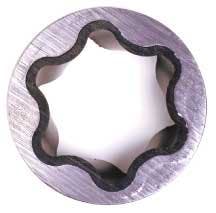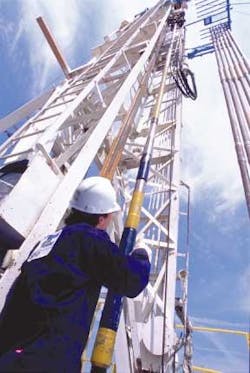RCLS, mud motor combination adds efficiencies
Precise wellbore placement without reduced penetration rates
Operators around the world have experienced the benefits of rotary steeringand closed-loop (RCLS) navigation. RCLS technology has lowered cost, improved drilling performance, and hit targets too small or too risky to hit with other technologies. However, RCLS technology has not replaced motor drilling technology, which operators still rely on in many areas of the world to steer and drill their directional, horizontal, and extended reach wells. The combination of motor drilling and RCLS technologies looks to drive efficiencies even further.
The mud motor remains an important tool for a large part of the worldwide drilling industry. Many advances have been made in mud motor design since its introduction over 30 years ago. These advances have resulted in dramatic increases in power generation, efficiency, and reliability. However, the fundamental operating principle of mud motors remains similar to the very earliest designs.
Recognizing this fact, drilling experts undertook a project to re-engineer the fundamental mud motor design. Their efforts produced a proprietary, first-of-its-kind mud motor technology that delivers high levels of power to the bit while increasing downhole reliability. As a result of this innovative design, they had to create a new manufacturing process to build it as well as re-engineer the materials used.
Drilling experts developed a new mud motor called X-treme, which incorporates a pre-contoured steel stator in the motor power section. The new stator design enables the motor to deliver more power than conventional elastomer-based drilling motors. Pre-contoured steel lobes of the stator replace the thick, molded elastomer lobes of conventional motors, offering the rotor a steel base to push against instead of an elastomer base. Now, elastomer is used not as an integral part of the power section but as a thin uniform coating to protect it.
Because the new combined RCLS/motor systems feature a modular BHA architecture, the motor can be positioned directly above the steering unit to deliver maximum power to the bit.
The steel motor construction provides reliability, because it does not break or chunk like elastomer can under extreme drilling conditions. Also, the motor design delivers more power at all flow rates, generating 50-100% greater torque than standard motors using conventional, elastomer-based, stators. Because of this, the motor’s length-to-power output is optimized and reliability is increased for higher penetration rates, at all flow rates, for use in the most difficult drilling environments.
Intelligence, power combined
While performance motor drilling delivers high power directly to the bit for higher penetration rates, operations associated with directional drilling control and physical hole quality offset some of the resulting time savings. Additionally, while RCLS technology eliminated the inefficiencies of conventional directional drilling control for improved gross ROP, these systems’ instantaneous ROP in some formations was often lower, indicating the potential for further performance improvement. In addition, when attempting to maximize ROP with rotary steerable assemblies, it is sometimes necessary to rotate the drillstring at speeds approaching the limit of the rig’s rotary capability. This can place increased loads on the rotary system that could, in turn, lead to downtime and higher rates of casing and drill pipe wear than would otherwise be experienced.
Due to these factors, it was not long before drilling experts combined the two technologies. In fact, these new high power pre-contoured motors were already running successfully in the vertical closed loop steering system. While not all rotary steerable systems can operate below such high power motors, drilling experts designed the latest generation system with a very high rotary speed specification (up to 400 rpm).
null
In addition, the latest-generation RCLS systems feature modular bottom hole assembly (BHA) architecture for more versatile BHA make-ups. By positioning the motor immediately above the RCLS steering unit and below the integrated MWD/LWD system, high power from the motor goes directly to the bit with the minimum of BHA length below the motor.
Drilling experts built hard-wired BUS communications into the motor to transmit electrical power and data between the MWD systems and RCLS steering mechanism. This provides full communication with the steering unit’s near bit inclinometer and diagnostic monitoring systems for maintenance of the already accepted precise steering control. As a result, the motor’s high torque and medium-speed capabilities combined with the high rotary speed capabilities provide more horsepower directly to the drill-bit. Another benefit of the high combined (motor + drillstring) rotary speed specification allows sufficiently high drillstring rotary speed to be applied when necessary to assure continuous hole cleaning, even at the anticipated higher rates of penetration.
null
Using the new AutoTrak X-treme system, drilling experts can obtain precise wellbore placement in the most complex well profiles without restricting penetration rates. Also, drilling experts can reduce surface rotary speed without sacrificing ROP, thus lowering stress on the rig’s rotary systems and reducing wear rates. In addition, the system’s reliability makes it an excellent choice for harsh drilling environments and extended reach applications, which include 3-D performance drilling, reducing casing/drillstring wear, extending drilling reach/drilling rig capabilities, rotary drilling through tubing, and re-entry drilling.
In an extended reach 8 1/2-in. horizontal well recently drilled offshore Denmark, a 6 3/4-in. version of the new system doubled penetration rates while simultaneously reducing by half the total drill-string revolutions. In addition, the system extended the previously limited drilling envelope and achieved significantly more reservoir exposure per well.
On a well offshore Aberdeen, use of this new system doubled ROP in a complex horizontal section in a known tough drilling area. A major independent benchmarking authority benchmarked this well as achieving best in class drilling performance since records began.
A recent run in Oman demonstrated the system benefits on land as well, even though the majority of RCLS/motor applications are anticipated to be on offshore wells. The customer drilled three horizontal wells in the same field. The goal was to maintain the laterals as flat as possible for improved production while maximizing ROP to lower drilling costs.
null
The customer used a 4 3/4-in. RCLS system on the two initial wells to maintain optimal steering performance and TVD control (+/-0.2°). The customer drilled the first well with a tri-cone bit achieving penetration rates of 49 ft/hr. Although the TVD control was excellent, ROP was slower than conventionally drilled offsets (60-70 ft/hr) and the customer experienced stick-slip vibration. The customer employed a PDC bit on the second well and increased ROP to 97.9 ft/hr (a 99% improvement over well No. 1). However, high surface torque and stick-slip vibration were still evident.
On the third and final well, the customer employed a 4 3/4-in. version of the new combined system and PDC bit to drill 1,970 ft in 14.7 drilling hr. The 134-ft/hr penetration rates represented a 37% improvement over well No. 2. Once again, TVD control was excellent and, due to the addition of the downhole motor on this run, the customer greatly reduced surface torque and stick-slip on this well.




